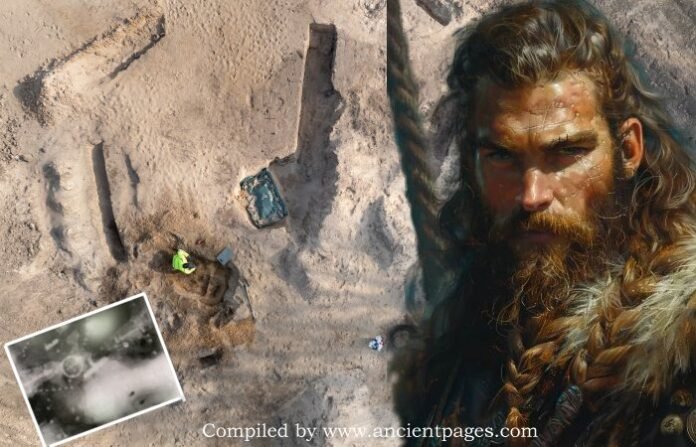Jan Bartek – AncientPages.com – A fascinating new discovery from the Viking Age has been made in Denmark. Located seven kilometers north of Aarhus, near the town of Lisbjerg, archaeologists have found 30 graves from this era.
Several graves contained intriguing artifacts, including pearls, coins, ceramics, an unusual box adorned with pearls and gold thread, a pair of scissors, and human remains in the form of teeth and bones. This finding provides valuable insights into Viking burial practices.
Credit: Moesgaard Moesgaard, MythologyArt. Image compilation AncientPages.com
Stormandsgården at Lisbjerg underwent its first archaeological excavation by Moesgaard experts in 1989. The site was notably enclosed by a unique palisade fence, featuring a three-meter-wide entrance portal facing south, which provided access to Aros via the ancient main road.
Excavation of a burial site. Credit: Moesgaard Moesgaard
This fenced area spanned approximately 19,000 square meters, equivalent to 0.19 square kilometers, or 2 hectares. Approximately one kilometer away from this site are Viking graves believed to date back to the latter half of the 9th century and are considered pagan in nature.
Sharpening stones and ceramics were found in the graves. Credit: Moesgaard Moesgaard
These graves varied in size and contained diverse grave goods, indicating that individuals of different social standings—possibly including a noble family and their slaves—were interred here.
X-ray photograph of the Lisbjerg box, showing a cross-shaped fitting on the lid as well as beads, scissors and gold thread inside the box. Credit: Moesgaard Moesgaard
One grave contained a coffin likely belonging to an important woman buried with ornaments and personal items; it is among the few known examples of its kind, with another similar find located in Haldum, roughly 12 kilometers from Lisbjerg.
Pearls found in the tombs. Credit: Moesgaard Moesgaard
In the vicinity of Aarhus, numerous significant artifacts and Viking Age settlements have been unearthed. During this era, Aarhus was one of Denmark’s most pivotal and ancient cities, acting as both a royal center and an international trade hub. The old main road was closely connected to Lisbjerg Manor House during this period.
See also: More About Vikings
“The burial site is most likely associated with the nobleman’s farm in Lisbjerg from the Viking Age, located less than a kilometer away. The objects found in the graves indicate that the buried were people of high status—it could be the extended family from the farm itself,” says Mads Ravn, head of local cultural heritage at Moesgaard and a PhD in archaeology specializing in the Viking Age.
See also: More Archaeology News
“The finds in Lisbjerg are part of a series of previous discoveries in the Aarhus area. Together, they depict an aristocratic environment connected to royal power and part of the Vikings’ vast and dynamic world,” says Kasper H. Andersen, a historian at Moesgaard specializing in the Viking Age.
Written by Jan Bartek – AncientPages.com Staff Writer











